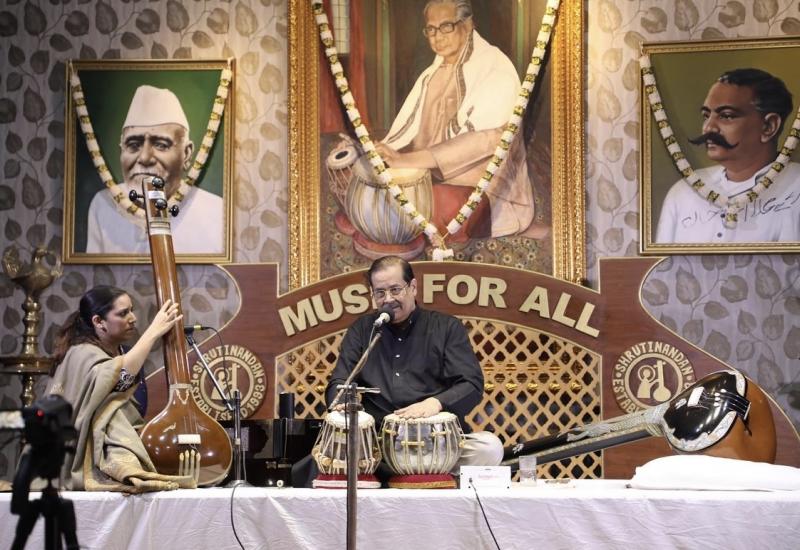Dancing Through the Years
What do an 85-year-old Methodist born in Grantham, a 43-year-old refugee from Sri Lanka and a 58-year-old Parsi born in Dar es-Salaam have in common? The answer is that they all attend Indian classical dance classes for adults.
Happily for those who had always wished to dance but lacked the opportunity or time, there are now a number of classes available: if you were to look in on a class these days, you would see learners in their 20s, 30s and 40s; and you would also find others in their 50s, 60s and even into their 80s.
Any group of women in this wide age range will have had a variety of life experiences that feed into their dance practice. I spoke to eight dance students to learn their stories.
Smita Kaushal, 39, and a specialist physiotherapist, was born in Kullu, Himachal Pradesh, India. She lives with her husband and 2-year-old son in the UK. ‘I spent my childhood in one of the most beautiful hill stations in India, growing up amidst nature, surrounded by mountains and rivers in a lush green valley, with people who had a very simple way of life and a deep faith.’ She has had a keen interest in classical dance since childhood – ‘as soon as I heard the music, I couldn’t control myself’ – but there were no teachers and schools in the area. She had always loved bharatanatyam, but is happy to have found a local adult kathak class with Sujata Banerjee. She dances because it ‘makes you happy inside… brings satisfaction and peace… it changed my life.’
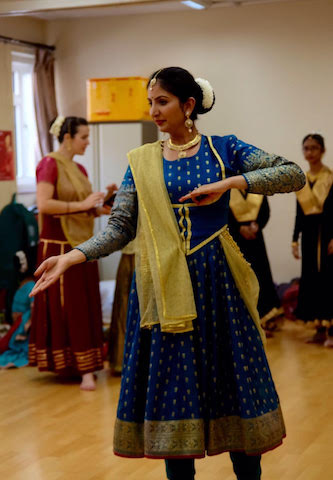
Pallavi Singh has found that her dance classes have helped her to recover from serious illness, as well as fulfil a desire held since childhood. Pallavi, 45, was born in Bhopal, India and came to the UK 14 years ago. Her two daughters (now 20 and 16) had been attending kathak classes since the ages of 12 and 8. ‘I used to watch them and think, one day I will do that’. When she was 39 she had to give up her job as a software consultant because of heart problems. ‘That’s when I started dancing’. She joined the classes when she was around 40, the oldest student in the class, and loved them. Her daughters, who were at higher grades, used to teach her, and they can now practise together. She had a setback with a pulmonary embolism in 2017, and even with blood thinners and bleeding, she continued to go to classes. ‘Dance class has given me a lot of strength to come out of my illness…a lot of energy… It is like a meditation for me, a therapy’. She says she tries to push herself, and has recently passed the Grade 5 exam with distinction. ‘It is something I do for myself; others walk, or cycle – this is me time for myself… a different world.’ Pallavi is now also working for Sujata Banerjee Dance Company.
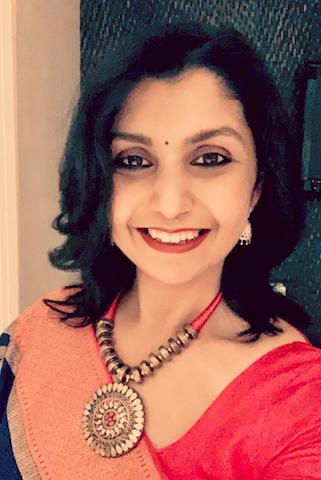
Kirti Vaidya, 40, is an architect by training. She was born in Mumbai. When she was 7 or 8 her mother had enrolled her in bharatanatyam classes, but the family moved often so her classes were curtailed. It was not until the summer of 2016, in the UK, when she saw Sujata Banerjee’s kathak classes for adult beginners in Harrow, that she started to dance again, aged 36. She finds her aptitude for learning starts with the toras and tukras, which she can grasp more quickly than the steps. Smita (above) commented that it was the other way round for her, as she can mirror the steps but really has to work on the toras and tukras. Kirti says, ‘if anyone loves dancing, any classical dance form, put their heart and soul into it and give it a go’.
For one bharatanatyam student, the cultural connections the form provides to her roots are key. Thevaki Mahadevan was born in Jaffna, Sri Lanka and came as a refugee to the UK in 1992 aged 12 because of the civil war. Thevaki, now 43, has a Chemistry PhD and is a data analyst in the pharmaceutical industry. She has three children aged 13, 10 and 8. In 2015 the Tamil school at Wembley High School had been offering Sunday Summer School bharatanatyam classes for parents. She hesitated to join when another mother suggested it – she had never had lessons, whereas other class members had. Would she keep up? However, she did keep up, and is now learning with Stella Subbiah at UYIR, the community dance organisation whose ‘aim is to enrich lives with a focus on the arts and culture of our home land – Sri Lanka’. The dance gives her, she says, both physical and mental benefits. She finds connections on many levels, and although she relates to the songs and stories herself, she makes the point that bharatanatyam should be available to all adults who are keen for a challenge – it is not necessary to know the stories or the language; and it is ‘no longer a dance form only for the young kids’.
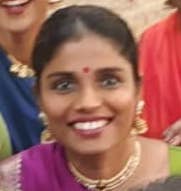
Odissi student Behroz Rustumji, 58, was born in Dar es-Salaam in Tanzania. She has a science degree and is a civil servant. She has three adult children and two grandchildren. Music is important in her family (her daughter is now a professional violinist), and it was when she attended a Bhavan open day with her daughter, who was interested in joining carnatic violin classes, that Behroz tried out an odissi taster lesson for fun and loved it. She has had classes with Urbi Basu, Ashvini Keshavan and now with Katrina Rute. She had never danced in the past apart from once as part of a community show and never had any classes. ‘To be honest now I am 58, I just don't know how I let myself miss out for so long.’ How does she feel about performing? ‘Strangely, old age has removed any inhibitions about performing, so I love it!’ [Though we don't necessarily agree about 'old age' at 58.] She has performed at end-of-year Bhavan concerts and in 2019 she performed a duet at Sadlers Wells' Elixir Festival. ‘As long as my body works and I don't hold back my beautiful younger classmates, I will continue to enjoy odissi dance classes.’
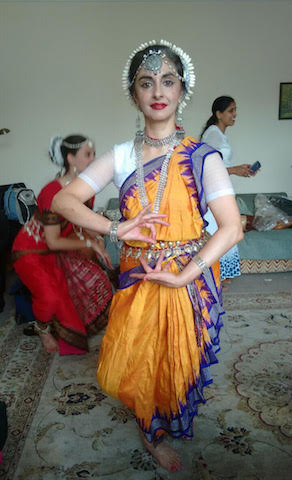
Christine Goodwin was born in London and trained as a philosopher (she studied the Vedas and the Bhagavad Gita as part of her first degree), and psychoanalyst. Now aged 63, she has danced all her life. ‘It is a central part of me.’ She saw the film Latcho Drom in the 1960s, and studied flamenco, belly dancing and turned with dervishes. Christine started kathak in her 40s, joining a class with 4-year-olds – but felt she would need a lifetime to learn. She continued classes later but felt it was not right for her body. Flamenco had already been physically punishing. As time went on she wanted to learn how to tell stories. She has been learning odissi with Elena Catalano for about three years. She loves the Gita Govinda: ‘opening the book feels like opening the heart’. Odissi ‘offers something architectural, with the shapes that it forms, and spiritual content’. She finds that odissi gives her more and more, especially as she has grown older. ‘It may be the last thing I’m able to do… Dance is essential to the human soul’. She practises more than she has ever done, because it is hard, and she doesn’t know how long she can continue. She is something of a technophobe, but she says of the Zoom classes during lockdown, ‘It has kept us all going – it is vital to us’.
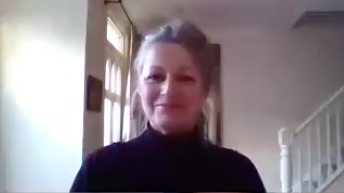
Sue Spencer was born in Edinburgh. She is 66 and a secondary school teacher. There has always been a dancer within her: ‘When I was a little girl I used to put on a towel and a toddler’s harness with bells and danced with mum and dad’ – it was like dancing ‘with bells and a dupatta’. She learned ballet when she was small and lived in Hong Kong, and wanted to be a ballet dancer. Later, at university in Durham, she would go clubbing four times a week. However, it took a while to find the right style to learn, and longer to be able to give time to it. When she was 40, during Indian Independence celebrations, Sujata Banerjee introduced her to the Dance Camp being run in Bedford, following which she attended some weekly odissi classes in Bedford with Sanjeevini Dutta. However, it has only been since she has retired that she has been able to attend classes regularly, first with Katie Ryan and then with Elena Catalano – as many as three classes a week on Zoom during lockdown – though this can be tiring. She finds a deep connection with odissi – spiritual, physical, mental. Through it she feels ‘connected with the great things of the world… I feel wonderful... it is joyful, being a part of that group.’
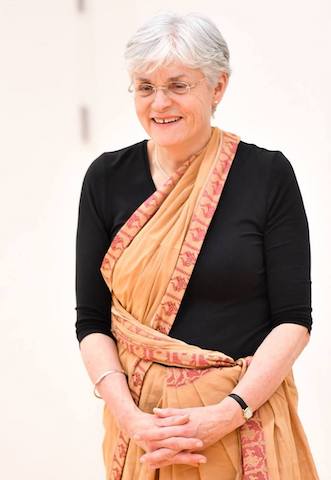
Joy Foxley was born in Grantham and lives with her husband Eric in Nottingham. She has been involved, together with Eric, in English traditional dance, music and song since about 1954. Her Methodist background, plus experience of living in the diverse communities of Nottingham, have introduced her to a variety of cultures. 85 now, she started kathak classes with Nilima Devi at the Nottingham Hindu Temple in about 1982 – a colleague at the primary school at which she was teaching persuaded her to go to Indian dance classes starting there, when the other students were mostly teenagers. ‘It hooked me, it drew me in.’ Joy continued when the classes moved to Leicester. When in 1985 her husband said, ‘Do something special for your 50th birthday’, encouraged by Nilima, she resigned her teaching post and went to study dance in India. She joined Janaki Ben Damle’s school of kathak dance in Baroda, Gujarat, with her friend Catherine, staying for six months on her first trip. She went on to achieve distinctions in the state third and fourth year kathak exams. Janaki had died after Joy’s second trip, and in 1991 she went to study at Kumudini Lakhia’s Kadamb dance college in Ahmedabad, the first of three visits there.
In 1986, Joy became a peripatetic teacher and took classes in Indian culture and dance at schools all over the county, as well as sessions in libraries, colleges, and youth and other groups all over England and even in Germany (with her daughter-in-law interpreting). More recently she has helped in various places at events being run by Nilima Devi, and in the north west by Bisakha Sarker.
The roof space in her house has been converted to a dance studio with mirrors. Her classes continue at home when Covid permits; and she and Catherine go occasionally to Nilima Devi’s CICD for refresher lessons and new compositions. ‘I look forward to becoming competent and able!’.
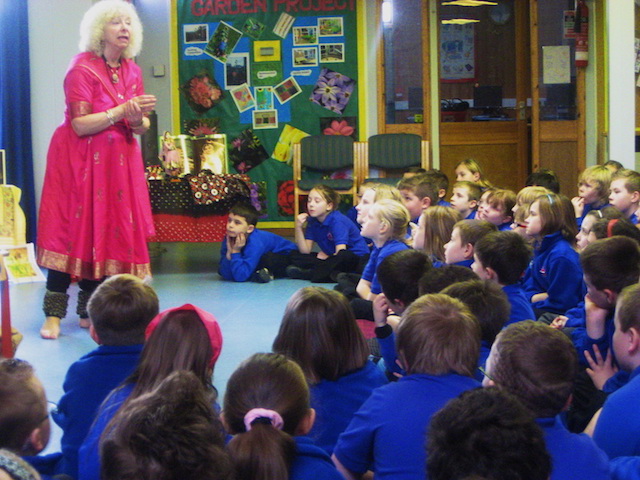
PC: Eric Foxley
The availability of classes clearly makes an important contribution to the happiness and well-being of many older women. The approach to performance, however, changes with age: those under 60 are happier to perform. Kirti, for example, says she loves performing and being part of a team, with the preparation, costume, make-up – and being shouted at by their teacher as if they were 12-year-olds. Smita feels performing is a good way of showing what one has learned, and she appreciates the encouragement. Sue, however, ‘can’t think of anything worse’; some older dancers don’t want to be letting the other dancers down. It is encouraging that some teachers are providing sessions for the over-50s or 60s. Several commented on how yoga, which has been incorporated by teachers in their classes, is enabling them to continue dancing as they grow older.
All those who have families at home appreciate their support and encouragement; and mothers, children and grandchildren are justly proud of these dancers. They will all continue as long as they are able. May it be for many years more.












